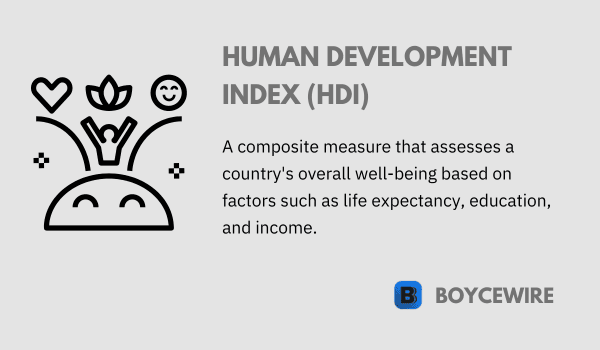Human Development Index: Definition, Components & Examples

What is the Human Development Index?
The Human Development Index (HDI) is a vital tool used by economists and policy makers around the globe to gauge the overall health and living conditions of a nation. Created by the United Nations Development Programme (UNDP) in 1990, the HDI moves beyond traditional measures of economic wealth, such as Gross Domestic Product (GDP), to present a more holistic perspective on a nation’s wellbeing.
It achieves this by incorporating three fundamental dimensions of human development – health, knowledge, and living standards. The importance of HDI lies in its ability to encapsulate a broad range of human capabilities, and to present a more nuanced picture of national progress beyond mere economic metrics. This composite index has greatly influenced global development policy, underscored the multidimensionality of human development, and initiated rich dialogues about national priorities and goals.
Key Points
- The Human Development Index (HDI) is a measure of overall human development that combines indicators of life expectancy, education, and income.
- The HDI provides a broader view of development beyond economic measures alone, emphasizing the importance of health and education.
- The HDI is calculated by assigning values to each dimension and combining them into a single index.
Understanding the Human Development Index
The Human Development Index (HDI) is an innovative statistical tool that provides a composite measure of human development across countries. The purpose of the HDI is to assess the overall level of development for a country and to provide a means for comparing these levels across different nations.
Unlike traditional measures of economic performance like Gross Domestic Product (GDP), the HDI seeks to offer a broader perspective on a country’s progress. It accomplishes this by incorporating key elements of human development, namely, health, education, and income levels.
Here’s a brief overview of these three critical components:
- Health The health component is measured by life expectancy at birth. It indicates the overall health environment in a country, including access to healthcare, sanitation, and nutritious food, among other factors.
- Education The educational component is gauged by two indicators: expected years of schooling for children of school-entry age and mean years of schooling for adults aged 25 years and older. It emphasizes the importance of knowledge acquisition and skill development for human progress.
- Living Standards The living standard dimension is evaluated by Gross National Income (GNI) per capita. It provides a snapshot of the average income of the residents of a country, indicating their access to economic resources and opportunities.
By synthesizing these three components, the HDI provides a robust, multidimensional perspective on the development scenario of a country. It signifies that human development is not merely about economic progress, but also about improving people’s lives, increasing their ability to participate fully in society, and expanding their opportunities and freedoms. In the following sections, we will delve into each component of the HDI in detail, its calculation, and its global applications.
Components of the Human Development Index
The Human Development Index is comprised of three core components: Health, Education, and Standard of Living. Each of these dimensions represents a critical aspect of human life and societal development. Let’s examine each in more detail.
- Health Health is a fundamental human right and a crucial indicator of human development. In the context of the HDI, health is measured through life expectancy at birth. This metric provides a snapshot of the overall health and well-being of a population. A higher life expectancy suggests better access to healthcare, improved nutrition, a cleaner environment, and other factors that contribute to a population’s health.
- Education Education is both a goal in itself and a means to improve other aspects of human development. The HDI measures education through two sub-indices: the expected years of schooling that a child starting school can expect to receive if prevailing patterns of age-specific enrolment rates persist throughout the child’s life, and the mean years of schooling for adults aged 25 years and more. These measures reflect the distribution of education attainment in a population and help in understanding the quantity and quality of the learning environment.
- Standard of Living The third component of the HDI, standard of living, is evaluated based on Gross National Income (GNI) per capita expressed in purchasing power parity dollars (PPP$). GNI per capita provides an estimate of the average income of a country’s citizens. A higher GNI per capita indicates a higher standard of living, assuming income is evenly distributed.
Each of these three dimensions holds equal weight in the calculation of the HDI. They are combined into a geometric mean, which ensures that a significant shortfall in any one dimension cannot be compensated by large increases in the others, underscoring the importance of a balanced development approach. This encourages policy-makers to pay equal attention to all three dimensions when making decisions that affect the welfare of the citizens. In the next section, we will further delve into how these components are used to calculate the HDI.
Importance of the Human Development Index
The Human Development Index (HDI) plays a significant role in providing a comprehensive perspective on a nation’s overall development. While conventional measures like Gross Domestic Product (GDP) only evaluate economic output, the HDI takes a broader view, considering factors such as health, education, and standard of living. This holistic approach makes the HDI an instrumental tool for policymakers, economists, and researchers worldwide.
Here are some reasons why the HDI is essential:
- Multidimensional Perspective The HDI includes not just income, but also education and health dimensions, providing a more comprehensive view of a country’s development status. This multidimensional perspective recognizes that human development is about more than just economic growth.
- Policy Implications The HDI is a practical tool that can guide policymakers towards more inclusive and people-centric policies. By highlighting gaps in health, education, and income, the HDI can help identify areas that require policy intervention.
- Global Comparisons The HDI enables comparisons between different countries, providing a standard measure of human development across the globe. This can help in the sharing and implementation of successful development strategies among nations.
- Tracking Progress By regularly updating the HDI, changes in a country’s human development can be tracked over time. This can help in assessing the effectiveness of development programs and policies.
- Promotes Balanced Development The HDI, by considering multiple facets of human development, encourages a balanced approach to development. It underscores the idea that excessive focus on any single aspect of development (like economic growth) without due attention to others (like education or health) can lead to unbalanced and unsustainable growth.
- Encourages Investment in Human Capital By placing health and education alongside income, the HDI sends a strong message that investment in people, or human capital, is as important as economic growth for a country’s overall development.
In essence, the Human Development Index serves as a reminder that the ultimate goal of economic policies and growth should be to improve human lives. Thus, it continues to inspire countries worldwide to strive for higher human development by promoting health, education, and equitable living standards.
Limitations of the Human Development Index
While the Human Development Index (HDI) is a powerful tool for comparing the general level of human development across different countries, it does come with certain limitations:
- Simplicity The HDI simplifies complex aspects of human development into three basic dimensions: health, education, and standard of living. This simplicity is part of its appeal, as it provides a clear and easily understood comparison. However, it also means that the HDI does not capture all aspects of human development, such as inequality, political freedom, or environmental factors.
- Equal Weighting The HDI assigns equal weights to its three components. This implies that health, education, and standard of living are equally important, which may not necessarily reflect the realities of every society. For instance, in some countries, education might be a higher priority than standard of living.
- Quantitative Measures The indicators used in calculating the HDI are quantitative and do not necessarily capture the quality of services provided. For instance, in the education dimension, the HDI does not distinguish between the quality of education received in different countries. The same goes for health services.
- Data Limitations The HDI relies on statistical data that may not be entirely accurate or consistent across different countries. Data quality, availability, and collection methods vary from country to country, which can affect the accuracy of the HDI.
- Does not account for Inequalities The HDI is an average measure and does not account for inequalities within countries. Two countries with the same HDI can have different levels of inequality, and thus, different distributions of human development.
To address some of these limitations, the United Nations Development Programme (UNDP) has developed complementary indices, such as the Inequality-Adjusted Human Development Index (IHDI) and the Gender Development Index (GDI). However, it’s important to remember that no single index can capture the full complexity of human development.
Alternatives to the Human Development Index
While the Human Development Index (HDI) is widely used, there are other indices that also strive to measure the wellbeing and development of countries beyond simply economic performance. These include:
- Inequality-adjusted Human Development Index (IHDI) The IHDI modifies the HDI to account for inequality within countries. The IHDI is essentially the HDI discounted, or reduced, according to the level of inequality.
- Multidimensional Poverty Index (MPI) The MPI identifies multiple deprivations at the household and individual level in health, education, and standard of living. It uses micro data from household surveys, and—unlike the Inequality-adjusted Human Development Index—all the indicators needed to construct the measure must come from the same survey.
- Gross National Happiness (GNH) This concept measures the collective happiness in a nation. Originating in Bhutan, the GNH is premised on the belief that sustainable development should take a holistic approach towards notions of progress and give equal importance to non-economic aspects of well-being.
- Gender Development Index (GDI) This index is designed to measure gender equality. The GDI is the ratio of the HDIs calculated separately for females and males using the same methodology as the HDI. It reflects the human development impact of gender inequality.
- Sustainable Development Goals Index (SDGI) This index measures the progress towards the Sustainable Development Goals, a set of 17 global goals set by the United Nations General Assembly. The SDGI tracks each country’s performance on the goals and provides a ranking of countries.
- Happy Planet Index (HPI) The HPI measures sustainable well-being for all. It uses global data on life expectancy, experienced well-being and Ecological Footprint to calculate this.
- Social Progress Index (SPI) The SPI measures the extent to which countries provide for the social and environmental needs of their citizens. It focuses on outcomes such as health, sanitation, shelter, education, access to technology, and personal rights.
These indices, while not perfect, provide a more comprehensive view of a nation’s health, wellbeing, and progress, taking into account a broader set of factors than traditional economic measures.
Examples of Human Development Index Application
The Human Development Index (HDI) is an incredibly versatile tool that has been employed in a number of ways by various organizations and entities around the world. Here are a few examples of its application:
- International Comparisons – One of the most common uses of the HDI is for making international comparisons regarding the level of human development in different countries. By comparing HDI scores, observers can make generalized assessments about which countries are more developed and which are less so. For instance, according to the 2020 UN Human Development Report, Norway, Ireland, and Switzerland had the highest HDI values, signifying a very high level of human development
- Policy Planning and Development – Governments often use HDI as a tool in their policy planning. By understanding where their country falls on the HDI, policymakers can prioritize resources and strategies to areas that need improvement
- Non-governmental Organizations (NGOs) – NGOs and international bodies like the United Nations use the HDI to target areas of the world that need assistance. By identifying countries with low HDI, these organizations can provide targeted aid and development programs
- Research and Study – Academics and researchers use the HDI to study trends in human development, draw correlations with other factors such as political systems, economic models, conflict, environmental issues, etc. It serves as a valuable data point in a myriad of research fields
- Investment Decisions – Businesses and investors also look at HDI as part of their decision-making process. Countries with high HDI may offer more robust markets and stable investment environments
In all these ways and more, the HDI serves as a powerful tool in assessing and improving the well-being of societies across the globe.
FAQs
The Human Development Index (HDI) is a statistical tool developed by the United Nations to measure and compare the social and economic development of countries.
The HDI measures a country’s development based on three dimensions: life expectancy at birth, education (measured by literacy rate and school enrollment), and standard of living (measured by per capita income).
The HDI is calculated by assigning a value to each dimension, which is then combined into a single index using a standardized formula. The resulting index ranges from 0 to 1, with higher values indicating higher levels of human development.
The HDI provides a broader perspective on development beyond economic indicators alone, emphasizing the importance of health, education, and living standards. It helps policymakers and researchers assess and compare the overall well-being of populations across countries.
About Paul
Paul Boyce is an economics editor with over 10 years experience in the industry. Currently working as a consultant within the financial services sector, Paul is the CEO and chief editor of BoyceWire. He has written publications for FEE, the Mises Institute, and many others.

Further Reading
 Price Elasticity of Demand: Definition, Types & Examples - Price Elasticity of Demand (PED) measures how customers change their behaviour when prices change. In other words, it refers to…
Price Elasticity of Demand: Definition, Types & Examples - Price Elasticity of Demand (PED) measures how customers change their behaviour when prices change. In other words, it refers to…  Effects of Inflation: Positive & Negative Effects - Some of the common effects of inflation include; loss in purchasing power, higher asset prices, rising inequality, and impacts on…
Effects of Inflation: Positive & Negative Effects - Some of the common effects of inflation include; loss in purchasing power, higher asset prices, rising inequality, and impacts on…  Finance Charge - A finance charge is the fee or interest imposed by a lender on a borrower for the use of credit…
Finance Charge - A finance charge is the fee or interest imposed by a lender on a borrower for the use of credit… 
